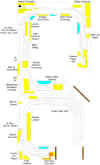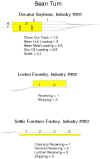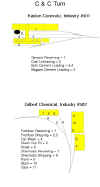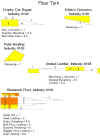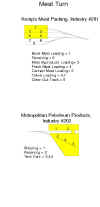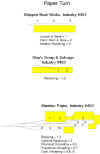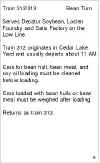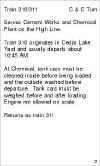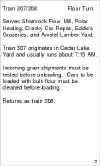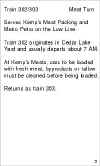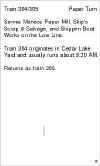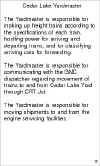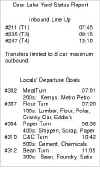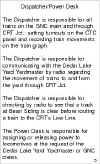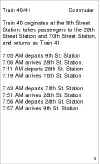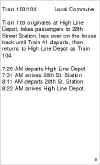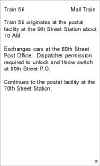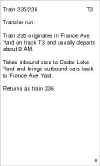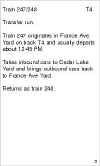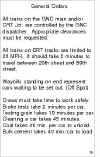Cedar River Terminal
When we moved to a single-level townhome in 1994, we had a hard time finding one with room for a model railroad. We finally found a two-bedroom with den unit where the railroad could take over one of the bedrooms and the den. We are an unusual family since we both participate in this hobby. Instead of a living room, we had a crew lounge. In our dining room, we had a railroad library. A fast time clock hung in the entry way where it could be seen from either the crew lounge or the library. And our breakfast nook was converted to a dispatcher's office. Not many model railroaders could get away with having railroading take over the whole house.
The den and second bedroom were located side by side so we tunneled through the wall to connect the tracks in them but operators had to walk out the door of one and down the hall to the door of the other. We solved the problem of the time that took by modeling one side of the wall as an underpass under 29th street and the other side as an underpass of 59th street. Since it would take a train some time to go from 29th to 59th, we had our operators pull up to the signals there, stop their trains, and walk into the other room before their trains could move again.
This is the first of our railroads to have really big industries. Our research led us to the conclusion that many industries today are huge. They may have have multiple buildings with several tracks. Some of those tracks may be special purpose such as car cleaning or grain testing. By including those tracks and their car movements on our model railroad, we were able to pack an amazing amount of industry work into little space.
That work meant we needed special paperwork for our crews. Spot diagrams told them which work was done on which tracks. Train briefs provided instructions as to which industries required what types of work. And general orders told them how that work was to be done.
To encourage operators to think even more about what real railroad crews do, we provided HO scale ground crews to take along on local switch jobs to throw the turnouts and uncouple cars. It is amazing what thought is required to have a crew on the ground in the right place at the right time.
We bought this house before it was actually built so we were able to get special wiring done. Because we wanted to use Bruce Chubb's CMRI to run the CTC mainline on this railroad, and because the dispatcher's office was three rooms away from the railroad, we had serial cables built into the walls of our new home. The dispatcher could sit at the computer in the office and set signals and throw turnouts on the distant railroad, just as the real railroads do. And the fast clock in the dispatcher's office ran off the same control box as those in the lounge and the railroad rooms assuring they would all stay in sync.
The dispatcher also played the role of power desk. Instead of crews going to the computer to assign their trains to their throttles, they called the power desk and requested assignment. With a couple of clicks the work was done. This meant when a crew requested power for a train coming out of hidden staging, the dispatcher could set the turnouts and the signals, before assigning the power avoiding the possibility of a train moving in staging before its tracks were aligned.
Track Plan
Spot Diagrams
Train Briefs
Other Paperwork
Photos

Checking the track drawing to see if it really works.

Making sure cars on planned tracks will clear lumber sheds.

Installing retaining wall makes signal very visible.

CRT engines on the ready tracks await crews hanging around the crew shack on the other side of the pedestrian bridge.

Classification tracks on the left, arrival/departure tracks on the right, and paper buildings in the background.

The main line passes under the 28th St. depot. Hovind Industries was custom built to help camouflage the window behind it.

From left to right: the low line, bean processing, the high line, commuter train on the main, and the post office.

Shamrock Flour's five tracks. The one in the near left corner is the short lead everyone wished was half a truck longer.

HO crews about to cross the pedestrian bridge to the engine facilities as their shift begins.
More Photos

Shamrock Flour, Polar Heating, and Cranky Car. Card boxes are for staging tracks behind fascia.

Eddie's Groceries and Amstel Lumber with card boxes for entire Flour Turn.

HO crews and their ready room beside the caboose track.

28th St. depot at the left, caboose track in the middle, engine facility at the back.

Classification yard on the lower level, arrival/departure yard on the upper level, off-line industries in the background.

More classification yard on the lower level, arrival/departure yard on the upper level, off-line industries in the background.

Platform for the meat packing plant, the building must have still been under construction. Off-line buildings around it.

Metro Petro in the middle, Decatur Bean on the right, the post office just barely visible behind the tower at CRT Jct. Those are coal loads on the shelf of the Freight Agent's desk.

Decatur Bean on the left, the post office peaking out from behind it, the signals from trains coming off the high line and from staging, Sattis Factory on the right.

Sattis Factory on the left, Losten Foundry behind it, Kasten Concrete on the High Line, Shippen Boat Works on the right.

Shippen Boat Works and Skip's Scrap on the Low Line. Off-line industry on the High Line.

Gilbert Chemical and High Line Depot on the High Line. Coal cars at Manitou Paper Mill on the Low Line.

Manitou Paper Mill
Odd Events
One day our operators had arrived and signed up for jobs, the fast clock was running, and the crews should have been hard at work. But they were standing around the crew lounge and library talking. I asked why and they sent me to the HO scale crew ready room. There were my little people holding strike signs! They were demanding an increase in wages! So we doubled everyone's wages and they all went happily to work.
Another day, I heard the sound of sirens coming from the back room. Arriving on the scene, I found a mob all staring at one point with no trains running on the high line or low line. High above the tracks there perched an HO figure. I was told he'd threatened to commit suicide by jumping onto the tracks when the next train passed. So, of course, all rail traffic stopped until police could be called to talk him down. Fortunately, we had a Washington County deputy sheriff operating that night so he talked the jumper down and operations resumed.
We wanted our operating crews to behave as if our model railroad was a real railroad--be careful what you wish for.
